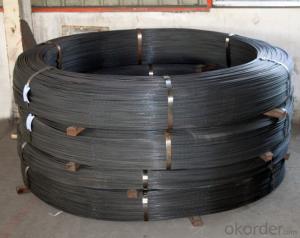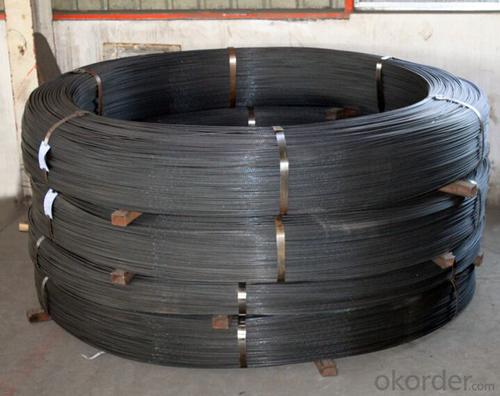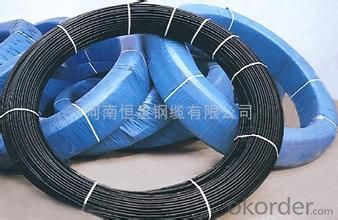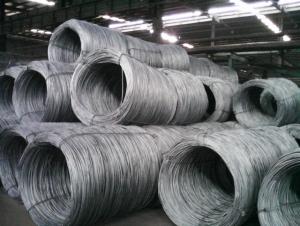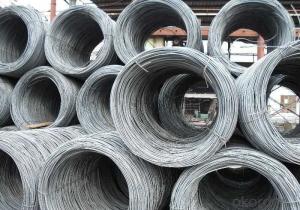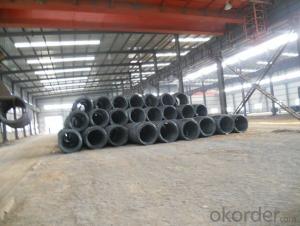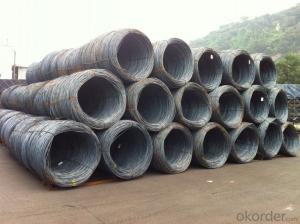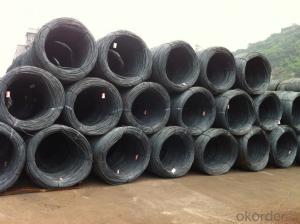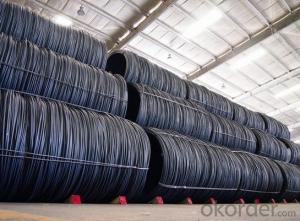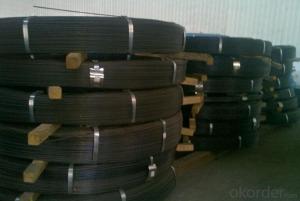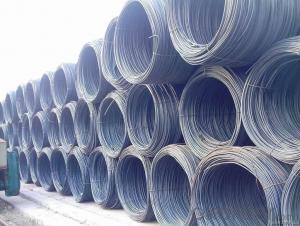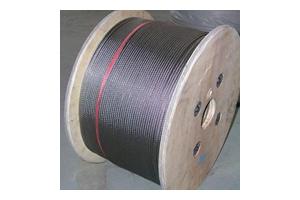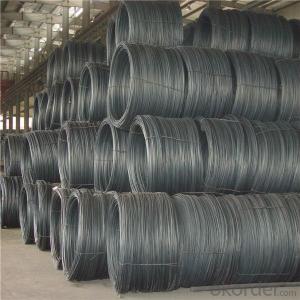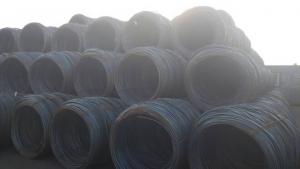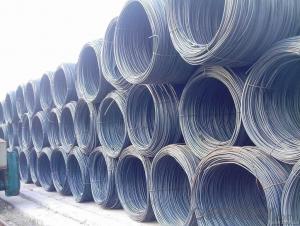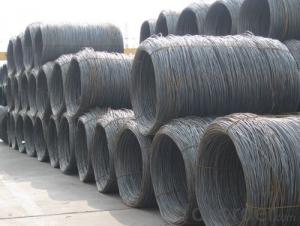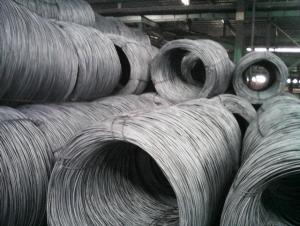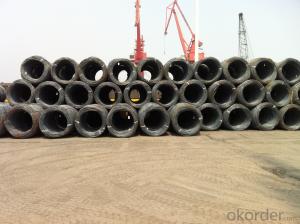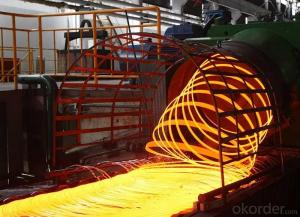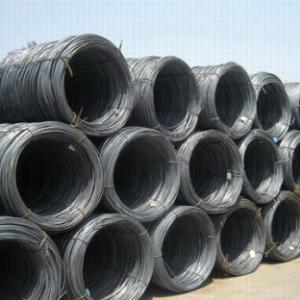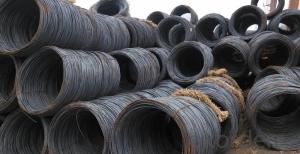Alloy Strand Steel Wires
- Loading Port:
- China Main Port
- Payment Terms:
- TT or LC
- Min Order Qty:
- -
- Supply Capability:
- -
OKorder Service Pledge
OKorder Financial Service
You Might Also Like
Quick Details
| Steel Grade: | SWRH77B, SWRH82B | Standard: | ASTM,BS,GB,JIS | Wire Gauge: | 4.0mm-10.0mm |
| Place of Origin: | Tianjin China (Mainland) | Type: | Drawn Wire,Spiral/Helical Ribs, Round Plain | Application: | Construction |
| Alloy Or Not: | Is Alloy | Special Use: | Free Cutting Steel | Model Number: | 4.0-10.0mm |
| Product Name: | prestressed steel wire 4mm high carbon steel wire | Size: | 4.0-10.0mm | ||
| Strength: | 1570/1670/1770/1860 N/mm2 | Relaxation: | Less than 2% (1000hour) | Elongation: | Not less than 4% |
| MOQ: | 10 Tons | Payment: | TT, LC | Delivery: | 10-15 work days |
| Package: | As your requirements |
Packaging & Delivery
| Packaging Detail:steel strand coil to be packed in damp proof materials strapped with 8 bands on one wooded pallet with an outer layer of plastic used for anti-rainshower 2 or 3 wooden block undermeath each coil. | |
| Delivery Detail:within 2 weeks |
Specifications
high carbon class A steel wire
Constructon:7 steel wire
material:wire 82B
FAQ of Alloy Strand Steel Wires
①How is the quality of your products?
Our products are manufactured strictly according to national and internaional standard, and we take a test
on each product before delivered out. If you want see our quality certifications and all kinds of testing report, please just ask us for it.
Guaranteed: If products’ quality don’t accord to discription as we give or the promise before you place order, we promise 100% refund.
②How about price?
Yes, we are factory and be able to give you lowest price below market one, and we have a policy that “ for saving time and absolutely honest business attitude, we quote as lowest as possible for any customer, and discount can be given according to quantity”,if you like bargain and factory price is not low enough as you think, just don’t waste your time.Please trust the quotation we would give you, it is professional one.
③Why should you chose us?
Chose happens because of quality, then price, We can give you both.Additionally, we can also offer professional products inquiry, products knowledge train(for agents), smooth goods delivery, exellent customer solution proposals.Our service formula: good quality+good price+good service=customer’s trust
SGS test is available, customer inspection before shipping is welcome, third party inspection is no problem.
Alloy Strand Steel Wires Images
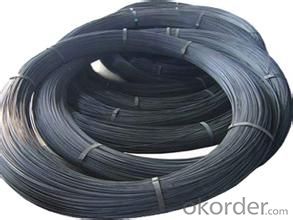
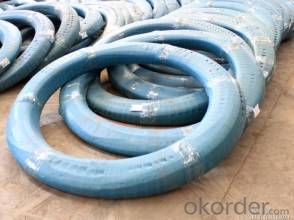
Any question, pls feel free to contact us !
- Q: What are the advantages of using steel wire rod compared to other materials?
- There are several advantages of using steel wire rod compared to other materials. Firstly, steel wire rod offers superior strength and durability. Steel is known for its high tensile strength, which means it can withstand heavy loads and resist deformation. This makes it an ideal material for various applications that require strong and reliable support, such as in construction, manufacturing, and transportation industries. Secondly, steel wire rod has excellent flexibility. Its elasticity allows it to bend and twist without breaking, making it suitable for applications that require dynamic movement or vibrations, such as in suspension systems, springs, and wire ropes. This flexibility also makes it easier to handle and install in various settings. Additionally, steel wire rod is highly resistant to corrosion. It can withstand exposure to moisture, chemicals, and extreme weather conditions without rusting or deteriorating. This resistance to corrosion makes steel wire rod a long-lasting and low-maintenance option, reducing the need for frequent replacements and repairs. Moreover, steel wire rod is readily available and cost-effective. Steel is one of the most commonly used materials worldwide, which means it is readily available in various shapes, sizes, and grades. This availability makes it easy to source and procure steel wire rod, reducing lead times and costs associated with production. Furthermore, steel's recyclability makes it a sustainable and environmentally-friendly choice. Lastly, steel wire rod offers versatility in terms of its applications. It can be used in a wide range of industries and settings, such as in construction, automotive, aerospace, agriculture, and telecommunications. Its adaptability and compatibility with various manufacturing processes make it a go-to material for many engineering and construction projects. In conclusion, the advantages of using steel wire rod compared to other materials include its superior strength, flexibility, corrosion resistance, availability, cost-effectiveness, and versatility. These qualities make steel wire rod a reliable and efficient choice for a wide range of applications.
- Q: How is steel wire rod used in the manufacturing of wire mesh cable trays?
- Steel wire rod is used in the manufacturing of wire mesh cable trays as it serves as the primary material for creating the interwoven mesh structure. The wire rod is drawn, stretched, and shaped to form individual wires that are then woven together to create a strong and durable mesh. This mesh structure provides excellent support and containment for cables, ensuring their organized and safe installation in various industrial and commercial settings.
- Q: What are the main factors affecting the market partnerships of steel wire rod?
- The main factors affecting the market partnerships of steel wire rod include the demand and supply dynamics of the steel industry, price fluctuations, competition among suppliers, technological advancements, regulatory policies, and the economic stability of the countries involved. Additionally, factors such as quality standards, customer preferences, and the ability to meet specific requirements also play a significant role in shaping market partnerships in the steel wire rod industry.
- Q: How are steel wire rods used in the manufacturing of wire baskets?
- Steel wire rods are an essential component in the manufacturing process of wire baskets. These rods serve as the foundation and structural framework for the baskets. They are typically made from high-quality steel that provides strength, durability, and resistance to corrosion. The first step in using steel wire rods for wire basket manufacturing involves cutting them into the desired lengths. These lengths can vary depending on the size and design of the basket being produced. Once cut, the rods are then shaped into the appropriate form, which can be square, round, or rectangular, depending on the specific requirements of the basket. To create the wire basket, the shaped steel wire rods are interwoven or welded together. This process creates a sturdy mesh-like pattern, forming the body of the basket. The interlocking of the wire rods ensures the basket's structural integrity while allowing for ventilation and visibility. The steel wire rods used in wire basket manufacturing can also be coated or treated to enhance their properties. For example, they can be galvanized to provide a protective layer against rust and corrosion, making the basket suitable for outdoor use or in humid environments. Additionally, the rods can be coated with plastic or vinyl to add color and prevent scratching or damage to the items stored in the basket. Overall, steel wire rods are crucial in the manufacturing of wire baskets as they provide the necessary strength and structure for these versatile storage solutions. Their versatility allows for customization in terms of size, shape, and coating, making wire baskets suitable for a wide range of applications in various industries, including retail, agriculture, and transportation.
- Q: What are the common methods used to remove surface defects in steel wire rod?
- Some common methods used to remove surface defects in steel wire rod include grinding, polishing, shot blasting, and chemical cleaning. Grinding is the process of using abrasive materials to remove imperfections and create a smooth surface. Polishing involves using abrasive compounds and tools to achieve a high level of smoothness and shine. Shot blasting uses high-speed projectiles to remove dirt, rust, and scale from the surface of the wire rod. Chemical cleaning involves the use of acids or alkaline solutions to dissolve or neutralize surface contaminants. These methods help improve the appearance and quality of the steel wire rod.
- Q: What are the common industry qualifications for steel wire rod manufacturers?
- The common industry qualifications for steel wire rod manufacturers typically include a strong understanding of metallurgy, manufacturing processes, and quality control. Additionally, manufacturers should have relevant certifications such as ISO 9001 for quality management systems and ISO 14001 for environmental management systems. Compliance with industry standards such as ASTM International and European Norm (EN) is also crucial.
- Q: How is steel wire rod used in the manufacturing of wire for power generation systems?
- Steel wire rod is a crucial component in the manufacturing of wire for power generation systems as it serves as the raw material used to produce high-quality wires. These wires are then utilized in various applications within power generation systems, such as electrical transmission lines, cables, and conductors. The strength, durability, and conductivity of steel wire rod make it ideal for ensuring efficient power transmission and reliable performance in these systems.
- Q: What are the main factors influencing the choice of steel wire rod order return policy?
- The main factors influencing the choice of steel wire rod order return policy include customer satisfaction, market demand, product quality, legal requirements, and the company's overall business strategy.
- Q: How does the weight of steel wire rod vary with different diameters?
- The weight of a steel wire rod can vary with different diameters. Generally, as the diameter of the wire rod increases, its weight also increases. This is because the weight of a wire rod is directly proportional to its volume, which is determined by its diameter. The formula to calculate the weight of a wire rod is given by the equation: Weight = Volume × Density Since the density of steel remains constant, the weight of the wire rod primarily depends on its volume. The volume of a wire rod can be calculated using the formula for the volume of a cylinder: Volume = π × (diameter/2)^2 × length From this equation, it can be observed that the weight of a wire rod is directly proportional to the square of its diameter. This means that if the diameter of the wire rod is doubled, its weight will be four times greater. Similarly, if the diameter is halved, the weight will be only one-fourth of the original weight. Therefore, it can be concluded that the weight of a steel wire rod increases as the diameter increases. This relationship is important to consider when determining the weight requirements for various applications, such as construction, manufacturing, or engineering purposes.
- Q: What are the common applications of hot rolled steel wire rod?
- Hot rolled steel wire rod, being a versatile and strong material, finds numerous applications in various industries. Some of the most common applications of hot rolled steel wire rod include: 1. Construction: Hot rolled steel wire rod is extensively used in the construction industry for various purposes. It is commonly used in the production of concrete reinforcement bars (rebars) that provide strength and durability to buildings, bridges, and other infrastructure projects. Additionally, it is used for manufacturing fences, nails, and wire mesh, which are essential components in construction. 2. Automotive industry: Hot rolled steel wire rod is widely utilized in the automotive industry for the production of parts and components. It is used in the manufacturing of suspension systems, engine components, steering mechanisms, and various other automotive parts that require high strength and resilience. 3. Industrial machinery: Hot rolled steel wire rod is an essential material in the production of industrial machinery. It is used for manufacturing gears, shafts, bearings, and other components that require high strength, toughness, and resistance to wear and tear. 4. Wire products: Hot rolled steel wire rod is extensively used in the production of a wide range of wire products. It is used for manufacturing wire ropes, springs, cables, and other wire-based products that need to withstand heavy loads and provide reliability and durability. 5. Welding electrodes: Hot rolled steel wire rod is also used in the production of welding electrodes. These electrodes are used in various industries for welding and joining different types of metals. The high strength and ductility of hot rolled steel wire rod make it an ideal material for manufacturing welding electrodes. 6. Fasteners: Hot rolled steel wire rod is used for producing a variety of fasteners, such as bolts, screws, and nuts. These fasteners are widely used in industries like construction, automotive, and manufacturing, where strong and reliable connections are required. Overall, the common applications of hot rolled steel wire rod span across a wide range of industries, including construction, automotive, machinery, wire products, welding, and fasteners. Its strength, versatility, and durability make it an indispensable material in many manufacturing processes.
Send your message to us
Alloy Strand Steel Wires
- Loading Port:
- China Main Port
- Payment Terms:
- TT or LC
- Min Order Qty:
- -
- Supply Capability:
- -
OKorder Service Pledge
OKorder Financial Service
Similar products
Hot products
Hot Searches
Related keywords
